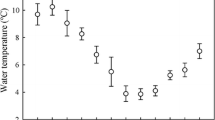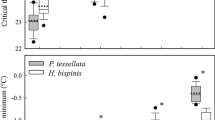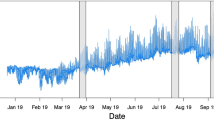Abstract
The native freshwater fish Galaxias platei shows a wide latitudinal distribution in Patagonia, being found on both sides of the Andes. Currently, climate change poses one of the main threats to native fish, and its effects are appearing faster in high southern latitudes. The aim of this work was to analyse the possible effects of climate change in G. platei through its thermal responses. We hypothesized that juveniles of this species would be affected by indirect rather than by direct consequences of climate change. We determined the thermal tolerance polygon using Critical Thermal Methodology and preferred temperatures using a thermal gradient. Additionally, we evaluated routine metabolic rate using stop-flow respirometry. Results showed an intermediate to large polygon, with a non-negligible portion acquired through acclimation. Preferred temperatures and routine metabolic rates were positively related to acclimation temperature. Results suggest that G. platei thermal tolerance is dependent on its prior thermal history, have a eurythermal nature but maintain high levels of cold tolerance. Moreover, G. platei would be better suited at maintaining homeostasis at highest temperatures where more energy could be available for growth. This is the first time that thermal ecology data are registered for this species at its southernmost distribution.



Similar content being viewed by others
References
Aigo, J., M. E. Lattuca & V. Cussac, 2014. Susceptibility of native perca (Percichthys trucha) and exotic rainbow trout (Oncorhynchus mykiss) to high temperature in Patagonia: Different physiological traits and distinctive responses. Hydrobiologia 736: 73–82.
Becker, C. D. & R. G. Genoway, 1979. Evaluation of the critical thermal maximum for determining thermal tolerance of freshwater fish. Environmental Biology of Fishes 4: 245–256.
Beitinger, T. L. & W. A. Bennett, 2000. Quantification of the role of acclimation temperature in temperature tolerance of fishes. Environmental Biology of Fishes 58: 277–288.
Beitinger, T. L. & R. W. McCauley, 1990. Whole-animal physiological processes for the assessment of stress in fishes. Journal of Great Lakes Research Elsevier 16: 542–575.
Beitinger, T. L., W. A. Bennet & R. W. McCauley, 2000. Temperature tolerances of North American freshwater fishes exposed to dynamic changes in temperature. Environmental Biology of Fishes 58: 237–275.
Beitinger, T. L. & W. I. Lutterschmidt, 2011. Measures of thermal tolerance. In Farrell, A. P. (ed), Encyclopedia of fish physiology: from genome to environment. Elsevier Inc, San Diego: 1695–1702.
Bennett, W. A. & T. L. Beitinger, 1997. Temperature tolerance of the sheepshead minnow, Cyprinodon variegatus. Copeia 1997: 77–87.
Bettoli, P., W. Neill & S. Kelsch, 1985. Temperature preference and heat resistance of grass carp, Ctenopharyngodon idella (Valenciennes), bighead carp, Hypophthalmichthys nobilis (Gray), and their F1. Journal of fish biology 27: 239–247.
Boy, C. C., A. F. Pérez, M. Tagliaferro, M. E. Lattuca, M. Gutiérrez & F. A. Vanella, 2017. Exploring bioenergetics of diadromous Galaxias maculatus in the southernmost extreme of its distribution: Summer is not always the better season. Journal of Experimental Marine Biology and Ecology 488: 102–110.
Brett, J. R., 1956. Some principles in the thermal requirements of fishes. The Quarterly Review of Biology 31: 75–87.
Campos, H., 1970. Introducción de especies exóticas y su relación con los peces de agua dulce de Chile. Mensual del Museo Nacional de Historia Natural 14: 6–9.
Chaui-Berlinck, J. G., L. H. A. Monteiro, C. A. Navas & J. E. P. W. Bicudo, 2002. Temperature effects on energy metabolism: a dynamic system analysis. Proceedings Biological Sciences/The Royal Society 269: 15–19.
Clavero, M. & E. García-Berthou, 2005. Invasive species are a leading cause of animal extinctions. Trends in Ecology Evolution 20: 110.
Correa, C. & A. P. Hendry, 2012. Invasive salmonids and lake order interact in the decline of puye grande Galaxias platei in western Patagonia lakes. Ecological Applications 22: 828–842.
Cox, D. K., 1974. Effects of three heating rates on the critical thermal maximum of bluegill In Gibbons, J. W., & R. R. Sharitz (eds), Thermal Ecology. National Technical Information Service, CONF-730505, Springfield, VA.
Crawley, N. E., 2013. The global impacts of climate change of fish. PhD Thesis 265.
Currie, R. J., W. A. Bennett & T. L. Beitinger, 1998. Critical thermal minima and maxima of three freshwater game-fish species acclimated to constant temperatures. Environmental Biology of Fishes 51: 187–200.
Cussac, V. E., S. Ortubay, G. Iglesias, D. Milano, M. E. Lattuca, J. P. Barriga, M. A. Battini & M. Gross, 2004. The distribution of South American galaxiid fishes: the role of biological traits and post-glacial history. Journal of Biogeography 31: 103–121.
Dabruzzi, T., W. A. Bennett, J. L. Rummer & N. A. Fangue, 2012. Thermal ecology of juvenile ribbontail stingray, Taeniura lymma (Forsskål, 1775), from a Mangal Nursery in the Banda Sea. Hydrobiologia 701: 37–49.
Dalvi, R. S., A. K. Pal, L. R. Tiwari, T. Das & K. Baruah, 2009. Thermal tolerance and oxygen consumption rates of the catfish Horabagrus brachysoma (Günther) acclimated to different temperatures. Aquaculture 295: 116–119.
Das, T., A. K. Pal, S. K. Chakraborty, S. M. Manush, N. Chatterjee & S. C. Mukherjee, 2004. Thermal tolerance and oxygen consumption of Indian Major Carps acclimated to four temperatures. Journal of Thermal Biology 2004: 157–163.
Davenport, J., 2012. Animal life at low temperature. Springer Science & Business Media, Berlin.
Díaz, F., A. D. Re, R. A. González, L. N. Sánchez, G. Leyva & F. Valenzuela, 2007. Temperature preference and oxygen consumption of the largemouth bass Micropterus salmoides (Lacépède) acclimated to different temperatures. Aquaculture Research 38: 1387–1394.
Di Santo, V. & W. A. Bennett, 2011. Is post‐feeding thermotaxis advantageous in elasmobranch fishes? Journal of Fish Biology 78: 195–207.
DiRienzo, J. A., F. Casanoves, M. G. Balzarini, L. Gonzalez, M. Tablada, & C. W. Robledo, 2011. Grupo InfoStat, Universidad Nacional de Córdoba, Córdoba, Argentina. URL http://www.infostat.com.ar.ISO690
Elliot, A., 2010. A comparison of thermal polygons for British freshwater teleosts. Freshwater Forum 5: 178–184.
Elliot, J. M., 1981. Some aspects of thermal stress on freshwater teleosts. In Pickering, A. D. (ed), Stress and fish. Academic Press, New York: 209–245.
Eme, J. & W. A. Bennett, 2009a. Critical thermal tolerance polygons of tropical marine fishes from Sulawesi, Indonesia. Journal of Thermal Biology 34: 220–225.
Eme, J. & W. A. Bennett, 2009b. Acute temperature quotient responses of fishes reflect their divergent thermal habitats in the Banda Sea, Sulawesi, Indonesia. Australian Journal of Zoology 57: 357–362.
Fangue, N. A. & W. A. Bennett, 2003. Thermal tolerance responses of laboratory acclimated and seasonally acclimatized Atlantic stingray, Dasyatis sabina. Copeia 2003: 315–325.
Feldmeth, R. C., E. A. Stone & J. H. Brown, 1974. An increased scope for thermal tolerance upon acclimating pupfish (Cyprinodon) to cycling temperatures. Journal of Comparative Physiology 89: 39–44.
Fernández, D. A., J. Ciancio, S. G. Ceballos, C. Riva-Rossi & M. A. Pascual, 2010. Chinook salmon (Oncorhynchus tshawytscha, Walbaum 1792) in the Beagle Channel, Tierra del Fuego: The onset of an invasion. Biological Invasions 12: 2991–2997.
Ficke, A., C. Myrick & L. Hansen, 2007. Potential impacts of global climate change on freshwater fisheries. Reviews in Fish Biology and Fisheries 17: 581–613.
Fry, F. E. J., 1971. The effect of environmental factors on the physiology of fish. Fish Physiology 6: 1–98.
Gille, S. T., 2002. Warming of the Southern Scean since the 1950s. Science. doi:10.1126/science.1065863.
Golovanov, V. K., 2006. The ecological and evolutionary aspects of thermoregulation behavior on fish. Journal of Ichthyology 46: 180–187.
Haak, A. L., J. E. Williams, H. M. Neville, D. C. Dauwalter & W. T. Colyer, 2010. Conserving peripheral trout populations: the values and risk of life on the edge. Fisheries 35: 530–549.
Hardewig, I., P. L. Van Dijk & H. O. Pörtner, 1998. High-energy turnover at low temperatures: Recovery from exhaustive exercise in Antarctic and temperate eelpouts. The American Journal of Physiology 274: R1789–R1796.
Hazel, J. R. & C. L. Prosser, 1974. Molecular mechanisms of temperature compensation in poikilotherms. Physiological Reviews 54: 620–677.
Heller, N. E. & E. S. Zavaleta, 2009. Biodiversity management in the face of climate change: A review of 22 years of recommendations. Biological Conservation 142: 14–32.
Hochachka, P. W. & G. N. Somero, 1971. Biochemical Adaptation to the Environment. In Hoar, W. S. & D. J. Randall (eds), Fish physiology. Academic Press, New York and London: 100–148.
Hundt, M., M. Schiffer, M. Weiss, B. Schreiber & C. M. Kreiss, 2015. Effect of temperature on growth, survival and respiratory rate of larval allis shad Alosa alosa. Knowledge and Management of Aquatic Ecosystems 416: 27.
Jobling, M., 1981. Temperature tolerance and the final preferendum-rapid methods for the assessment of optimum growth temperatures. Journal of Fish Biology 19: 439–455.
Jobling, M., 1994. Fish Bioenergetics - Fish and Fisheries Series 13. Chapman & Hall, London.
Jobling, M., 1996. Environmental biology of fishes. Fish and Fisheries Series 16. Chapman & Hall, London.
Johnson, J. A. & S. W. Kelsch, 1998. Effects of evolutionary thermal environment on temperature-preference relationships in fishes. Environmental Biology of Fishes 4: 447–458.
Kita, J., S. Tsuchida & T. Setoguma, 1996. Temperature preference and tolerance, and oxygen consumption of the marbled rockfish, Sebastiscus marmoratus. Marine Biology 125: 467–471.
Krogh, A., 1916. The respiratory exchange of animals and man. Longmans, London.
Lesica, P. & F. W. Allendorf, 1995. When are peripheral valuable populations for conservation? Conservation Biology 9: 753–760.
Magnuson, J. J., L. B. Crowder & P. A. Medvick, 1979. Temperature as an ecological resource. Integrative and Comparative Biology 19: 331–343.
McDowall, R. M., 1971. The galaxiid fishes of South America. Zoological Journal of the Linnean Society 50: 33–73.
Milano, D., 2003. Biología de Galaxias platei (Pisces, Galaxidae): Especializaciones relativas a su distribución. PhD Thesis, Universidad Nacional del Comahue.
Milano, D., D. E. Ruzzante, V. E. Cussac, P. J. Macchi, R. A. Ferriz, J. C. Macchi, M. E. Lattuca & S. J. Walde, 2006. Latitudinal and ecological correlates of morphological variation in Galaxias platei (Pisces, Galaxiidae) in Patagonia. Biological Journal of the Linnean Society 87: 69–82.
Mundahl, N., 1990. Heat death of fish in shrinking stream pools: Mechanisms for survival. American Midland Naturalist 123: 40–46.
Pascual, M. & J. E. Ciancio, 2007. Introduced anadromous salmonids in patagonia: risks, uses and a conservation paradox. In Bert, T. M. (ed.), Ecological and genetic implications of aquaculture activities. Springer, Berlin.
Pascual, M., V. Cussac, B. Dyer, D. Soto, P. Vigliano, S. Ortubay & P. Macchi, 2007. Freshwater fishes of Patagonia in the 21st Century after a hundred years of human settlement, species introductions, and environmental change. Aquatic Ecosystem Health & Management 10: 212–227.
Pörtner, H. O., 2010. Oxygen- and capacity-limitation of thermal tolerance: a matrix for integrating climate-related stressor effects in marine ecosystems. Journal of Experimental Biology 213: 881–893.
Pörtner, H. O. & M. A. Peck, 2010. Climate change effects on fishes and fisheries: towards a cause-and-effect understanding. Journal of Fish Biology 77: 1745–1779.
Prosser, C. L., 1986. Molecular mechanisms of temperature adaptation. American Association for the Advancement of Science, Washington, DC.
Richardson, J., J. A. T. Boubée & D. W. West, 1994. Thermal tolerance and preference of some native New Zealand freshwater fish. New Zealand Journal of Marine and Freshwater Research 28: 399–407.
Saad, J. F., M. R. Schiaffino, A. Vinocur, I. O’Farrell, G. Tell & I. Izaguirre, 2013. Microbial planktonic communities of freshwater environments from Tierra del Fuego: Dominant trophic strategies in lakes with contrasting features. Journal of Plankton Research 35: 1220–1233.
Sagarin, R. D. & S. D. Gaines, 2002. The “abundant centre” distribution: to what extent is it a biogeographical rule? Ecology Letters 5: 137–147.
Shultz, A. D., Z. C. Zuckerman & C. D. Suski, 2016. Thermal tolerance of nearshore fishes across seasons: implications for coastal fish communities in a changing climate. Marine Biology 163: 83. doi:10.1007/s00227-016-2858-2.
Shuter, B. J. & J. R. Post, 1990. Climate, population viability, and the zoogeography of temperate fishes. Transactions of the American Fisheries Society 119: 314–336.
Sogard, S. M. & M. L. Spencer, 2004. Energy allocation in juvenile sablefish: Effects of temperature, ration and body size. Journal of Fish Biology 64: 726–738.
Sollid, J., R. E. Weber & G. E. Nilsson, 2005. Temperature alters the respiratory surface area of crucian carp Carassius carassius and goldfish Carassius auratus. The Journal of experimental biology 208: 1109–1116.
Svendsen, M. B. S., P. G. Bushnell & J. F. Steffensen, 2016. Design and setup of intermittent-flow respirometry system for aquatic organisms. Journal of Fish Biology 88: 26–50.
Vanella, F. A. & J. Calvo, 2005. Influence of temperature, habitat and body mass on routine metabolic rates of Subantarctic teleosts. Scientia Marina 69: 317–323.
Wallman, H. L. & W. A. Bennett, 2006. Effects of parturition and feeding on thermal preference of Atlantic stingray, Dasyatis sabina (Lesueur). Environmental Biology of Fishes 75: 259–267.
Zar, J. H., 2010. Biostatistical Analysis. Prentice Hall - Pearson, London.
Zemlak, T. S., E. M. Habit, S. J. Walde, M. A. Battini, E. D. M. Adams & D. E. Ruzzante, 2008. Across the southern Andes on fin: glacial refugia, drainage reversals and a secondary contact zone revealed by the phylogeographical signal of Galaxias platei in Patagonia. Molecular Ecology 17: 5049–5061.
Acknowledgements
This work was partially supported by the Consejo Nacional de Investigaciones Científicas y Técnicas (CONICET) through the PIP 0321 and PIP 0440. Thanks to Daniel Aureliano and Marcelo Gutiérrez for technical assistance and Frank Sola for his assistance with the English language of the manuscript. We also acknowledge financial support in terms of post-doctoral grant from the CONICET (M.E. Barrantes).
Author information
Authors and Affiliations
Corresponding author
Additional information
Handling editor: Eric Larson
María Eugenia Barrantes and María Eugenia Lattuca contributed equally to the accomplishment of this work.
Rights and permissions
About this article
Cite this article
Barrantes, M.E., Lattuca, M.E., Vanella, F.A. et al. Thermal ecology of Galaxias platei (Pisces, Galaxiidae) in South Patagonia: perspectives under a climate change scenario. Hydrobiologia 802, 255–267 (2017). https://doi.org/10.1007/s10750-017-3275-3
Received:
Revised:
Accepted:
Published:
Issue Date:
DOI: https://doi.org/10.1007/s10750-017-3275-3




